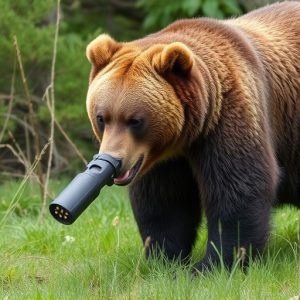Camping Safe: Understanding and Using Guard Alaska Bear Spray
Bear spray is an effective and environmentally conscious deterrent for bears in close proximity, for…….
Bear spray is an effective and environmentally conscious deterrent for bears in close proximity, formulated with capsaicin for rapid decomposition while minimizing ecological impact. Responsible camping practices include understanding and proper disposal methods to minimize harm to non-target wildlife, aquatic life, and plants. Safety precautions when handling Guard Alaska spray involve storing canisters responsibly, following usage instructions, and ensuring adequate training for deployment. Disposal should adhere to local regulations to prevent water contamination from the decomposition of chemical components, emphasizing the Environmental Effects of Bear Spray Decomposition. Understanding the proper usage and limitations of bear spray, influenced by environmental factors, is crucial for safety in areas with bear populations.
Camping enthusiasts, especially in bear country, rely on bear spray as a crucial defense. This guide explores the safety aspects of using Guard Alaska spray. We delve into the science behind its composition and efficacy against bears, understanding the environmental impact of its decomposition, and best practices for handling and disposal. By following safe protocols, campers can maximize protection while minimizing ecological effects, ensuring a memorable outdoor experience without unwanted encounters.
- Understanding Bear Spray: Composition and Efficacy
- The Environmental Impact of Bear Spray Decomposition
- Safe Handling and Disposal Practices for Guard Alaska Spray
- Best Practices for Camping Safety with Bear Spray
Understanding Bear Spray: Composition and Efficacy
Bear spray, also known as bear deterrent or bear defense spray, is a specialized pyrotechnic device designed to protect individuals from bears when they are in close proximity, especially during camping or hiking in bear country. Unlike traditional pepper spray used for self-defense against humans, bear spray is formulated to be more environmentally friendly and less irritating to the eyes while still being highly effective against bears.
The composition of bear spray includes a blend of capsaicin, a chemical derived from chili peppers, and other ingredients designed to break down rapidly in the environment. This is crucial as it minimizes the environmental impact compared to traditional chemicals that can persist in the ecosystem. The efficacy of bear spray lies in its ability to create a temporary but powerful barrier between the user and the bear. When sprayed, capsaicin irritates a bear’s eyes, nose, and throat, causing them to retreat or avoid the area. This rapid decomposition ensures that any residual spray is minimal and quickly breaks down into natural components, leaving no harmful traces in the environment.
The Environmental Impact of Bear Spray Decomposition
The decomposition of bear spray, like Guard Alaska, has significant environmental implications. While effective as a deterrant against bears, these sprays often contain potent chemicals that can persist in the ecosystem for extended periods. Components such as capsicum and other irritants may have adverse effects on non-target wildlife, aquatic life, and plants once the spray breaks down. The environmental impact goes beyond immediate use, as residuals can leach into soil and water sources, potentially affecting local ecosystems over time.
Understanding these environmental effects is crucial for responsible camping practices. Users of bear spray should be mindful of its disposal to minimize ecological harm. Proper disposal methods, such as following local guidelines for hazardous waste or using designated decontamination areas, help mitigate the spread of harmful substances. By taking these precautions, campers can enjoy a safer outdoor experience while also preserving the delicate balance of nature around them.
Safe Handling and Disposal Practices for Guard Alaska Spray
When handling Guard Alaska spray, always prioritize safety and environmental responsibility. Store the canister in a cool, dry place, out of reach of children and pets. Never leave it unattended or in extreme temperatures, as this can compromise its effectiveness and pose potential risks. Always follow instructions for proper usage, ensuring you are trained to deploy the spray correctly when encountering bears or other dangerous wildlife.
Disposal is another critical aspect of responsible bear spray management. Guard Alaska spray cans should not be disposed of like regular trash due to their active ingredients and potential environmental impact. Check local regulations for specific guidelines on disposal methods. Ideally, return empty canisters to retailers or drop-off points designed for hazardous waste, preventing the potential harm caused by improper disposal, including water contamination and ecological disruption resulting from the decomposition of bear spray’s chemical components.
Best Practices for Camping Safety with Bear Spray
When camping in areas known for bear populations, proper usage and understanding of bear spray is essential for your safety. Always check local guidelines and regulations regarding its use, as application techniques may vary. Before venturing into the wilderness, familiarize yourself with the product’s features and limitations.
Bear spray, when used correctly, can deter aggressive bears by creating a barrier of odor and irritants that temporarily disable their sense of smell and vision. However, it’s crucial to remember that environmental factors impact its effectiveness. The Environmental Effects of Bear Spray Decomposition play a role in its performance; wind direction, humidity, temperature, and the spray’s composition all contribute to how well it disperses and lingers. Understanding these variables can help campers make informed decisions about when and where to deploy bear spray during encounters.
Camping in bear country? Safe handling and proper disposal of Guard Alaska spray are essential components of your camping safety kit. By understanding the composition and efficacy of bear spray, recognizing its environmental impact, and following best practices for safe use, you can significantly reduce risks during your outdoor adventures while minimizing the environmental effects of bear spray decomposition. Remember, knowledge is key to a safer, more enjoyable experience in nature’s embrace.


